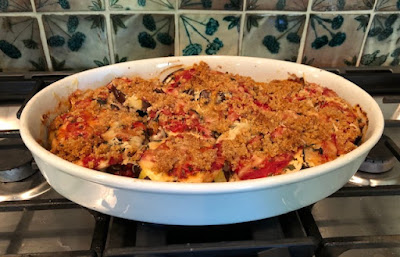Eggplant Gratin – Provençal Gratin d’Aubergine
Late summer brings both eggplant and tomatoes. That’s when in
the south of France Eggplant Gratin – “Gratin d’Aubergine” -- was was most
common in the old days. Now with produce available year round, the dish can be
enjoyed anytime.
Southeastern French cuisine includes many wonderful vegetable
gratins. There are seafood and meat gratins as well. “Gratin” indicates topping
with grated cheese and/or breadcrumbs and baking in a shallow dish till crispy
on top. Gratins of potatoes, cauliflower and other winter vegetables typically
lack tomatoes but contain milk, often in a creamy béchamel sauce. Two gratins
that I’ve had in France are different, eggplant gratin and “Tomates Provençale,”
which is a sort of gratin but not called that. Both contain cheese and
breadcrumbs plus tomatoes, but no milk. They both taste very fresh, and are
somewhat lighter than some of the winter gratin dishes.
Eggplant gratin has some similarities with Eggplant Parmesan, or “Melanzane alla
Parmigiana,” a dish from southwestern Italy, down the Mediterranean coast from
French Provence. But in the heavier Italian dish the eggplant slices are coated
with egg and flour or breadcrumbs and pre-fried or pre-baked before assembling
the dish. Plus considerable mozzarella cheese is used in addition to the
namesake Parmesan cheese. And there are no breadcrumbs in the topping. For
French eggplant gratin, which similarly uses Parmesan cheese, the eggplant is
merely salted to remove its bitterness, and mozzarella is not usual.
In this recipe, I use the traditional Parmesan cheese
(domestic is good enough for this baking), but in addition for a creamier
cheese inside the dish I use Gruyère, or for a more economical dish grated
Jarlsberg or “Swiss” cheese works satisfactorily. The dried herb mix “Herbes de
Provence” is an important seasoning for this dish. It’s available at the spice
and herb section at most supermarkets. A substitute would be a mixture of
thyme, marjoram and oregano.
The recipe serves six as a luncheon or principal dish, or
will serve more as a side dish. The gratin can be made ahead and re-heated
before the meal.
This dish pairs nicely with lighter-bodied red wines (chilled
about 20 minutes in the fridge before drinking to take off the summer warmth).
A red Beaujolais, Côtes du Rhône, or Pinot Noir will work and be geographically
appropriate.
2 medium eggplants (about 1-1/2 pounds)
2 tablespoons salt for soaking the eggplant
3 tablespoons olive oil for the casserole dish
1/4 pound (about 3/4 cup) grated Gruyère or Swiss cheese
(domestic)
1 (14-ounce) can crushed or “ground” tomatoes
1-1/2 teaspoons salt for the baking
2 teaspoons dry Herbes de Provence (or see notes above)
2 teaspoons chopped fresh basil leaves
1-1/2 cups grated Parmesan cheese (domestic wedge is OK)
5 tablespoons dry breadcrumbs mixed with 2 tablespoons olive
oil for topping
Rinse off the eggplants. In a large bowl, combine two quarts
of water with 2 tablespoons of salt. Cut stem tops off the eggplant and cut a
thin piece off the bottom ends. With a vegetable peeler or sharp knife cut off
three narrow strips of peel lengthwise equally separate from each other (so
skin isn’t continuous when the eggplant is sliced). Slice the eggplants
crosswise into 1/4-inch-thick circles. Soak these in the salted water, mixing
them occasionally, at least 30 minutes.
Open the can of crushed/ground tomatoes and mix in the 1-1/2
teaspoons of salt plus the Herbes de Provence and chopped fresh basil. Set
aside.
Set the oven for 350 degrees.
Using a shallow casserole dish from which the gratin will be
served, pour in 3 tablespoons of olive oil and tip the dish to have the oil
coat the bottom and part of the sides of the dish.
Drain the eggplant slices. Place half of them in the oiled
casserole dish, slightly overlapping. Press them down lightly. Sprinkle evenly
with half of the grated Gruyere or Swiss cheese. Then spoon half of the
crushed/ground tomatoes (containing the seasonings) evenly over the top.
Sprinkle with half the grated Parmesan. Then repeat these steps with the second
half of the ingredients, finishing with the Parmesan.
Moisten the breadcrumbs with the olive oil. With your fingers
crumble this evenly over the top of the casserole.
Bake in middle of oven until the juices are bubbling and the
topping begins to brown, about 40-50 minutes.
Serve hot. Or the baked casserole can be cooled,
refrigerated, and re-baked just long enough to heat through before serving.

.png)


